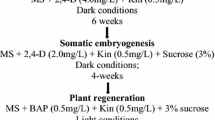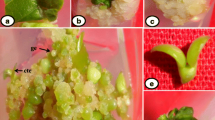Summary
Embryogenic callus was induced on segments of young leaves of sugarcane (Saccharum officinarum L.) cultured on Murashige and Skoog's medium supplemented with 0.5–3.0 mg/2,4-D, 5% coconut milk and 3–8% sucrose. The fourth and fifth leaves, especially their midrib and sheath regions within 5 cm from the leaf base, were most suitable for the induction of embryogenic callus. Many embryoids (= somatic embryos) were formed when the callus was transferred to low 2,4-D media (0.25–0.5 mg/l), or was allowed to remain on the high 2,4-D medium for a prolonged period. Plantlets obtained from the germination of embryoids were transferred to soil and grown to maturity.
The embryogenic callus was formed by divisions in mesophyll cells situated primarily in the abaxial half of the leaf, and also from cells of the vascular parenchyma. The embryoids developed by internal segmenting divisions in single richly cytoplasmic cells located at the periphery of the embryogenic callus and showed the typical organization of grass embryos.
Similar content being viewed by others
Abbreviations
- ABA:
-
abscisic acid
- AZG:
-
8-azaguanine
- BAP:
-
benzylaminopurine
- CCC:
-
chlorocholine chloride
- CH:
-
casein hydrolysate
- CM:
-
coconut milk
- 2,4-D:
-
2,4-dichlorophenoxyacetic acid
- GA:
-
gibberellic acid
- MS:
-
Murashige andSkoog's medium
- NAA:
-
naphthaleneacetic acid
- Picloram:
-
4-amino-3, 5, 6-trichloropicolinic acid
- YE:
-
yeast extract
References
Brettell, R. I. S., Wernicke, W., Thomas, E., 1980: Embryogenesis from cultured immature inflorescence ofSorghum bicolor. Protoplasma104, 141–148.
Chagvardieff, P., Bonnel, E., Demarly, Y., 1981: La culturein vitro de tissus somatiques de canne a sucre (Saccharum sp.). Agron. Trop.36, 266–278.
Chu, C. C., Wang, C. C., Sun, C. S., Hsu, C., Yin, K. C., Chu, C. Y., Bi, F. Y., 1975: Establishment of an efficient medium for anther culture of rice through comparative experiments on the nitrogen sources. Sci. Sinica18, 659–668.
Dale, P. J., Deambrogio, E., 1979: A comparison of callus induction and plant regeneration from different explants ofHordeum vulgare. Z. Pflanzenphysiol.94, 65–77.
Dudits, D., Nemet, G., Haydu, Z., 1975: Study of callus growth and organ formation in wheat (Triticum aestivum) tissue cultures. Can. J. Bot.53, 957–963.
Haccius, B., Bhandari, N. N., 1975: Delayed histogen differentiation as a common primitive character in all types of nonzygotic embryos. Phytomorphology25, 91–94.
Haydu, Z., Vasil, I. K., 1981: Somatic embryogenesis and plant regeneration from leaf tissues and anthers ofPennisetum purpureum Schum. Theor. appl. Genet.59, 269–273.
Heinz, D. J., 1973: Sugarcane improvement through induced mutations using vegetative propagules and cell culture techniques. In: Proc. Induced Mutations in Vegetatively Propagated Plants PL 501/5, 53–59.
—, 1977: Cell, tissue and organ culture in sugarcane improvement. In: Applied and Fundamental Aspects of Plant Cell, Tissue and Organ Culture (Reinert, J., Bajaj, Y. P. S., eds.), pp. 3–17. BerlinHeidelberg-New York: Springer.
Hendre, R. R., Mascarenhas, A. F., Nadgir, A. L., Pathak, M., Jagannathan, V., 1975: Growth of mosaic virus-free sugarcane plants from apical meristem. Indian Phytopathol.28, 175–178.
Ho, W. J., Vasil, I. K., 1983: Somatic embryogenesis in sugarcane (Saccharum officinarum L.). II. The growth of and plant regeneration from embryogenic cell suspension cultures. Ann. Bot.51, 719–726.
Kalaw, E. P., Tolentino, E. G., Rosario, E. L., 1977: Evaluation of sugarcane clones derived form callus tissues. Philippine J. Crop Sci.2, 195–196.
Koga, Y., Kudo, M., 1977: An efficient method of producing callus and plantlets by tassel culture for sugarcane breeding. JARQ11, 193–197.
Leu, L. S., 1972: Freeing sugarcane from mosaic virus by apical meristem culture and tissue culture. Rept. Taiwan Sugar Expt. Stn.57, 57–63.
Liu, M. C., Chen, W. H., 1974: Histological studies on the origin and process of plantlet differentiation in sugarcane callus mass. Proc. ISSCT15, 118–121.
Lu, C., Vasil, I. K., 1981: Somatic embryogenesis and plant regeneration from leaf tissues ofPanicum maximum Jacq. Theor. appl. Genet.59, 275–280.
McManus, J. F. A., 1948: Histological and histochemical uses of periodic acid. Stain Technol.23, 99–108.
Mori, K., 1971: Production of virus-free plants by means of meristem culture. JARQ6, 1–7.
Murashige, T., Skoog, F., 1962: A revised medium for rapid growth and bioassays with tobacco tissue cultures. Physiol. Plant.15, 473–497.
Nadar, H. M., Heinz, D. J., 1977: Root and shoot development from sugarcane callus tissue. Crop Sci.17, 814–816.
—,Soepraptopo, S., Heinz, D. J., Ladd, S. L., 1978: Fine structure of sugarcane (Saccharum sp.) callus and the role of auxin in embryogenesis. Crop Sci.18, 210–216.
Nickell, L. G., 1967: Tissue and cell culture for sugarcane research. Proc. ISSCT12, 887–892.
Payán, A. F., Carmen, H., Tascón, G., 1977: Técnicas para la micropropagación de la cana de azúcar (Saccharum officinarum L.) mediante el cultivo de tejidos y yemas. Acta Agronomica (Columbia)37, 43–79.
Ploper, L. D., Mariotti, J. A., 1978: Variabilidad en subclones obtenidos de cultivos. Rev. Ind. y Agricola de Tucuman55, 59–64.
—,Vazques de Ramallo, N. E., 1976: El cultivo “in vitro” de tejidos para la production de plantines de caña de azúcar. Rev. Ind. y Agricóla de Tucumán53, 43–52.
Vasil, I. K., 1982 a: Plant cell culture and somatic cell genetics of cereals and grasses. In: Plant Improvement and Somatic Cell Genetics (Vasil, I. K., Scowcroft, W. R., Frey, K. J., eds.), pp. 179–203. New York: Academic Press.
—, 1982 b: Somatic embryogenesis and plant regeneration in cereals and grasses. In: Plant Tissue Culture 1982 (Fujiwara, A., ed.), pp. 101–104. Tokyo: Maruzen.
—, 1983: Regeneration of plants from single cells of cereals and grasses. In: Genetic Engineering of Eukaryotes (Lurquin, P., Kleinhofs, A., eds.), pp. 233–252. New York: Plenum.
—,Vasil, V., Lu, C., Ozias-Akins, P., Haydu, Z., Wang, D. Y., 1982: Somatic embryogenesis in cereals and grasses. In: Variability in Plants Regenerated from Tissue Culture (Earle, E., Demarly, Y., eds.), pp. 3–21. New York: Praeger Press.
Vasil, V., Vasil, I. K., 1982: The ontogeny of somatic embryos ofPennisetum americanum (L.) K.Schum.: In cultured immature embryos. Bot. Gaz.143, 454–465.
Zeng, J. S., 1979:In vitro embryogenesis from somatic leaf callus of sugarcane. Acta Phytophysiologia Sinica5, 411–416.
Author information
Authors and Affiliations
Additional information
Florida Agriculture Experiment Station Journal Series No. 4189.
Rights and permissions
About this article
Cite this article
Ho, W.J., Vasil, I.K. Somatic embryogenesis in sugarcane (Saccharum officinarum L.) I. The morphology and physiology of callus formation and the ontogeny of somatic embryos. Protoplasma 118, 169–180 (1983). https://doi.org/10.1007/BF01281800
Received:
Accepted:
Issue Date:
DOI: https://doi.org/10.1007/BF01281800




